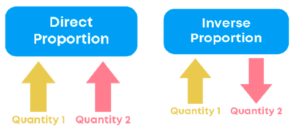[Please watch the video attached at the end of this blog for a visual explanation of ratios and proportions]
Today we’re focusing on the subtopic of Ratios and Proportions under the main topic of Numbers for Cambridge IGCSE Mathematics.
Ratios and proportions tend to confuse a lot of students due to them being more or less two sides of the same coin. However, they are very simple concepts in reality, which will be explained simply in the blog post below.
What are ratios?
The ratio is the comparison or simplified form of two quantities that are the same type. Under ratios, we basically look at the relationship in amounts between two or more things. Simply put, the ratio is the integer that can be utilized to indicate one quantity as a fraction of another quantity or quantities.
Ratios can be expressed using three methods:
b to c
b: c
b/c
The most frequently and commonly used symbol, however, is that of the colon (:), and this is what you should use in the exam as well unless the question asks you to use another symbol.
What are equivalent ratios?
Equivalent ratios are ratios that are the same when compared. For example, 2 : 3 and 4: 6 are equivalent ratios.
Example:
Since ratios look at the relationship in amounts between two or more things, we can consider the example below.
3: 2 (read 3 is to 2) means one particular person has 3 things of the amount while the other person has 2 things of the amount.

We also can use equivalent ratios. For example, if you have a ratio of 3:2, then if you multiply both sides by two, this ratio becomes 6:4, so both are considered equivalent ratios.
Similarly, if we have a ratio of 15:20 then we divide both sides by 5, and this results in 3:4 which is also an equivalent ratio.

What are proportions?
Proportion is an equation that determines that the given ratios are equivalent or corresponding to one another, that is, the proportion expresses the equality of ratios/ fractions.
Proportions are of a few types
- Direct Proportion
- Inverse Proportion
- Continued Proportion
However, what you need to learn for your syllabus is just direct proportion and inverse proportion, so you can happily cut the third type off your list ?.
Direct Proportion
In direct proportion, if one quantity increases, then the other quantity will increase as well. Similarly, if one quantity decreases, the other quantity will decrease as well.
If “A” and “B” are two quantities, then the direction proportion is presented as
A ∝ B.

An example of this from everyday life is the price of gas compared with the price of food. When the price of gas increases, the food price also increases. When the price of gas decreases, the price of food will decrease. Therefore, we can see that the price of gas is directly proportional to the price of food.
Inverse Proportion
In inverse proportion, the process is the complete opposite of direct proportion. Here, if one quantity increases, the other quantity will decrease, and vice versa.
An inverse proportion of two quantities “A” and “B” is presented as
A ∝ (1/B)

An example of this kind of proportion from everyday life would be the time taken to complete a task compared with the number of workers doing the work. When the number of workers increases, the amount of work will decrease, when the number of workers decreases, the amount of work will increase. Therefore, the amount of workers is inversely proportional to the work done.
Refer to these two diagrams to identify the difference between direct proportion and indirect proportion easily.

Remember in direct proportion, if one quantity increases, the other quantity will increase, and if one quantity decreases, the other quantity will decrease (the arrows both go in the same direction).
However, in inverse proportion, if one quantity increases, the other quantity will decrease (the arrows go in opposite directions).
Helpful points for practicing factors and proportions for your upcoming Cambridge IGCSE Mathematics exams.
Just like any other subject, Mathematics relies heavily on how well you prepare in advance for your exams. To make things easier, here are a few pointers that may help you get ready for your upcoming Cambridge IGCSE Mathematics exams.
Study the difference between factors and proportions.
Practice sample questions – Practise, practice, practice. Questions on ratios and proportions can be found with different levels of difficulty. Our question banks have questions of different difficulty levels that you can practice before your actual exams.
Practice past paper questions to familiarise yourself with the format of the questions and paper.
Ask for help – You are never too late to ask for assistance if you’re struggling. Reach out to us at Tutopiya to find the right tutor to help you pass your exams with flying colors!
Watch the video below for a visual explanation of ratios and proportions and attempt the quiz to challenge yourself!
